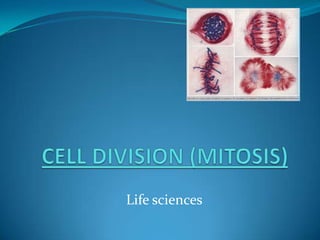
Chromosomes and Cell Division
- 2. CHROMOSOMES Chromosomes form when the chromatin network in the nucleus of the cell, coil up, shortens and thickens. Each organism has a specific amount of chromosomes. All humans have 46 chromosomes. These chromosomes are arranged in identical pairs called homologous chromosome pairs – Therefore humans have 23 homologous pairs of chromosomes. These chromosomes is only visible during cell division processes. One chromosome consist of 2 chromatids and one centromere that attach the chromatids together. Each chromatid consist of genes which in turn consist of DNA.
- 3. CHROMOSOME STRUCTURE X and Y chromosomes: gonosomes/sexchromosomes Colored bands represents different genes
- 4. THE PHASES OF THE CELL CYCLE CHAPTER 11 P. 164 The cell cycle includes the following phases: Interphase (include G1- , S- [DNA synthesis] and G2 phase) Mitosis Cytokinesis Growth The result is 2 identical cells.
- 5. Why is Mitosis important? Allow an organism to grow. Repairs damaged cells/tissue. Replace dead cells/tissue. Reproduction in some simple organisms.
- 6. Where does Mitosis take place? In all somatic cells (include all body cells and excludes the sex cells – sperm/egg cells)
- 7. The process of Mitosis. CONSIST OF A FEW PHASES: INTERPHASE PROPHASE METAPHASE ANAPHASE TELOPHASE BioFlix: Mitosis
- 8. INTERPHASE Cell builds up enough energy for division process. DNA replication occurs Cell look normal, like before division
- 9. PROPHASE Nuclear envelope and nucleolus disappear. Chromatin become more tightly coiled, and condenses into individual chromosomes. Chromosomes arrange randomly in the cell. Centrioli move to opposite poles, with spindle fibers stretching between them.
- 10. METAPHASE The centrioli reached the opposite poles with the spindle fibers in between. The chromosomes arrange randomly on the equator, each single chromosome attaching to a separate spindle fiber by means of the centromere.
- 11. ANAPHASE The spindle fibers pull tight. The centromers attaching the chromatids of the chromosomes split in half. Daughter chromosomes move to opposite poles.
- 12. EARLY TELOPHASE – KARYOKINESIS (DIVISION OF NUCLEUS Daughter chromosomes reach poles. Nuclear envelope surrounds chromosomes. Nucleolus reappear at each pole. Chromosomes become less condense forming chromatin. Two identical nuclei has been formed
- 13. LATE TELOPHASE – CYTOKINESIS (DIVISION OF THE CYTOPLASM) Invagination of the cytoplasm and plasma membrane occurs. (Cleavage furrow forms in animal cells and a cytoplasmic plate forms in plant cells) Continues until the cell in divided into 2 separate cells. (Identical to one another and to the original cell)
- 14. MITOSIS PROCESS
- 15. CANCER Chapter 11 p.170-171 Cancer is caused by the loss of cell cycle controls in cancer cells. Cancer cells usually continue to divide well beyond a single layer, forming a clump of overlapping cells called a tumor. Malignant tumors invade surrounding tissues and can metastasize exporting cancer cells to other parts of the body, where they may form secondary tumors. They do not exhibit anchorage dependence or density dependent inhibition.
- 16. Ovarian cancer cells Ovarian cancer cells dividing Breast tumor
- 17. Credit to J.Williamson E.Pretorius P. Stewart R Drevale K.Segui
